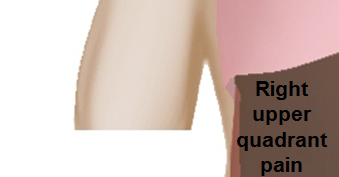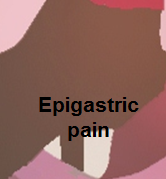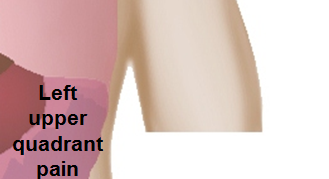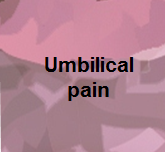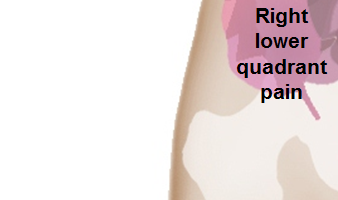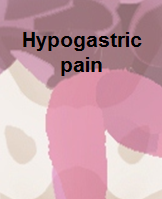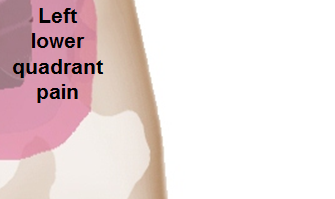| Disease
|
Clinical manifestations
|
Diagnosis
|
Comments
|
| Symptoms
|
Signs
|
| Abdominal Pain
|
Fever
|
Rigors and chills
|
Nausea or vomiting
|
Jaundice
|
Constipation
|
Diarrhea
|
GI bleeding
|
Hypo-
tension
|
Guarding
|
Rebound Tenderness
|
Bowel sounds
|
Lab Findings
|
Imaging
|
| Intussusception
|
Episodic
|
±
|
-
|
+
|
-
|
-
|
-
|
|
Positive if in shock
|
Positive if intestine perforated
|
Positive if intestine perforated
|
Decreased or hypoactive
|
|
- Ultrasound
- Target Sign/Doughnut sign
- Pseudo-kidney sign
- X-Ray
- Crescent sign
- Absence of air in RLQ,RUQ
- Distended loops of bowel
|
- Non-operative reduction done in stable patients
- Surgical reduction done if patient unstable/non-operative reduction completely unsuccessful
|
| Peptic ulcer disease
|
Diffuse
|
±
|
−
|
+
|
−
|
−
|
−
|
|
Positive if perforated
|
Positive if perforated
|
Positive if perforated
|
N
|
- Ascitic fluid
- LDH > serum LDH
- Glucose < 50mg/dl
- Total protein > 1g/dl
|
|
|
| Gastritis
|
Epigastric
|
±
|
−
|
+
|
−
|
−
|
−
|
+
|
−
|
−
|
−
|
N
|
|
|
|
| Gastroesophageal reflux disease
|
Epigastric
|
−
|
−
|
±
|
−
|
−
|
−
|
−
|
−
|
−
|
−
|
N
|
N
|
|
|
| Gastric outlet obstruction
|
Epigastric
|
−
|
−
|
±
|
−
|
−
|
−
|
−
|
−
|
−
|
−
|
Hyperactive
|
|
|
|
| Gastroparesis
|
Epigastric
|
−
|
−
|
+
|
−
|
−
|
−
|
−
|
±
|
−
|
−
|
Hyperactive/hypoactive
|
|
- Scintigraphic gastric emptying
|
- Succussion splash
- Single photon emission computed tomography (SPECT)
- Full thickness gastric and small intestinal biopsy
|
| Gastrointestinal perforation
|
Diffuse
|
+
|
±
|
-
|
±
|
−
|
−
|
+
|
+
|
+
|
±
|
Hyperactive/hypoactive
|
|
|
|
| Dumping syndrome
|
Lower and then diffuse
|
−
|
−
|
+
|
−
|
−
|
+
|
−
|
+
|
−
|
−
|
Hyperactive
|
|
|
|
| Disease
|
Abdominal Pain
|
Fever
|
Rigors and chills
|
Nausea or vomiting
|
Jaundice
|
Constipation
|
Diarrhea
|
GI bleeding
|
Hypo-
tension
|
Guarding
|
Rebound Tenderness
|
Bowel sounds
|
Lab Findings
|
Imaging
|
Comments
|
| Acute appendicitis
|
Starts in epigastrium, migrates to RLQ
|
+
|
Positive in pyogenic appendicitis
|
+
|
−
|
−
|
±
|
−
|
Positive in perforated appendicitis
|
+
|
+
|
Hypoactive
|
|
|
- Positive Rovsing sign
- Positive Obturator sign
- Positive Iliopsoas sign
|
| Acute diverticulitis
|
LLQ
|
+
|
±
|
+
|
−
|
+
|
±
|
+
|
Positive in perforated diverticulitis
|
+
|
+
|
Hypoactive
|
|
|
|
| Inflammatory bowel disease
|
Diffuse
|
±
|
−
|
−
|
±
|
−
|
+
|
+
|
−
|
−
|
−
|
Normal or hyperactive
|
|
|
Extra intestinal findings:
|
| Irritable bowel syndrome
|
Diffuse
|
−
|
−
|
−
|
−
|
±
|
±
|
−
|
−
|
−
|
−
|
N
|
Normal
|
Normal
|
Symptomatic treatment
|
| Whipple's disease
|
Diffuse
|
±
|
−
|
−
|
±
|
−
|
+
|
−
|
±
|
−
|
−
|
N
|
|
Endoscopy is used to confirm diagnosis.
Images used to find complications
|
Extra intestinal findings:
|
| Disease
|
Abdominal Pain
|
Fever
|
Rigors and chills
|
Nausea or vomiting
|
Jaundice
|
Constipation
|
Diarrhea
|
GI bleeding
|
Hypo-
tension
|
Guarding
|
Rebound Tenderness
|
Bowel sounds
|
Lab Findings
|
Imaging
|
Comments
|
| Tropical sprue
|
Diffuse
|
+
|
−
|
−
|
−
|
−
|
+
|
−
|
−
|
−
|
−
|
N
|
|
Barium studies:
- Dilation and edema of mucosal folds
|
|
| Celiac disease
|
Diffuse
|
−
|
−
|
−
|
−
|
−
|
+
|
−
|
−
|
−
|
−
|
Hyperactive
|
|
US:
- Bull’s eye or target pattern
- Pseudokidney sign
|
|
| Infective colitis
|
Diffuse
|
+
|
−
|
±
|
−
|
−
|
+
|
+
|
Positive in fulminant colitis
|
±
|
±
|
Hyperactive
|
|
CT scan
- Bowel wall thickening
- Edema
|
|
| Disease
|
Abdominal Pain
|
Fever
|
Rigors and chills
|
Nausea or vomiting
|
Jaundice
|
Constipation
|
Diarrhea
|
GI bleeding
|
Hypo-
tension
|
Guarding
|
Rebound Tenderness
|
Bowel sounds
|
Lab Findings
|
Imaging
|
Comments
|
| Colon carcinoma
|
Diffuse/ RLQ/LLQ
|
−
|
−
|
−
|
−
|
±
|
±
|
+
|
±
|
−
|
−
|
- Normal or hyperactive if obstruction present
|
- CBC
- Carcinoembryonic antigen (CEA)
|
- Colonoscopy
- Flexible sigmoidoscopy
- Barium enema
- CT colonography
|
- PILLCAM 2: A colon capsule for CRC screening may be used in patients with an incomplete colonoscopy who lacks obstruction
|
| Disease
|
Abdominal Pain
|
Fever
|
Rigors and chills
|
Nausea or vomiting
|
Jaundice
|
Constipation
|
Diarrhea
|
GI bleeding
|
Hypo-
tension
|
Guarding
|
Rebound Tenderness
|
Bowel sounds
|
Lab Findings
|
Imaging
|
Comments
|
| Spontaneous bacterial peritonitis
|
Diffuse
|
+
|
−
|
−
|
Positive in cirrhotic patients
|
−
|
+
|
−
|
±
|
+
|
+
|
Hypoactive
|
- Ascitic fluid PMN>250 cells/mm³
- Culture: Positive for single organism
|
- Ultrasound for evaluation of liver cirrhosis
|
|
| Small bowel obstruction
|
Diffuse
|
+
|
−
|
+
|
−
|
+
|
−
|
−
|
+
|
+
|
±
|
Hyperactive then absent
|
|
Abdominal X ray
- Dilated loops of bowel with air fluid levels
- Gasless abdomen
|
- "Target sign"– , indicative of intussusception
- Venous cut-off sign" – suggests thrombosis
|
|
|
|
|
|
|
|
|
|
|
|
|
|
|
|
|
|
| Volvulus
|
Diffuse
|
-
|
−
|
+
|
−
|
+
|
−
|
−
|
Positive in perforated cases
|
+
|
+
|
Hyperactive then absent
|
|
CT scan and abdominal X ray
|
|
